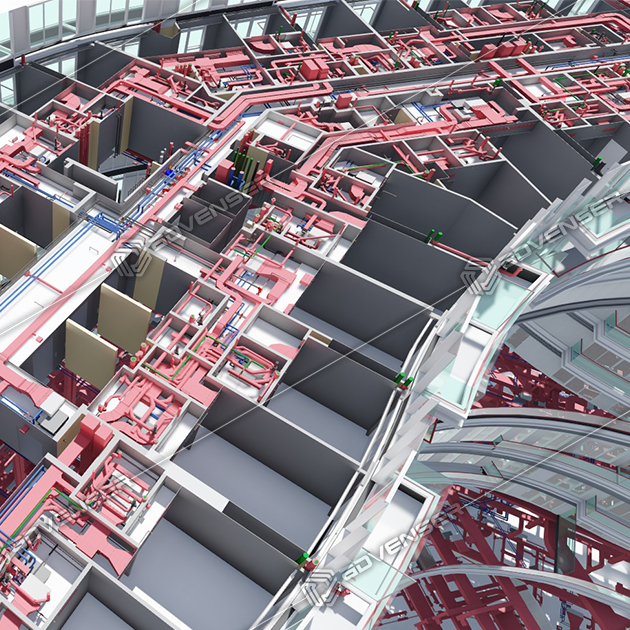As energy efficiency becomes a priority in building design, optimizing MEP (Mechanical, Electrical, and Plumbing) systems is essential for reducing operational costs and environmental impact. Modern MEP systems—such as advanced HVAC, energy-efficient lighting, and automated controls—help reduce energy consumption and adapt to the needs of occupants, contributing to lower greenhouse gas emissions and supporting sustainability goals.
Building Information Modeling (BIM) is a powerful tool that enables significant improvements in the energy efficiency of MEP systems. BIM allows architects and engineers to create 3D models with detailed data on materials, insulation, HVAC, lighting, and other MEP components, supporting precise energy performance simulations before construction. Additionally, BIM facilitates continuous monitoring during building operation, ensuring systems run at peak efficiency over their lifespan. This proactive approach aligns with sustainable building standards, reduces costs, and makes BIM an invaluable asset in eco-friendly construction.
Understanding BIM
Building Information Modeling (BIM) is a comprehensive digital representation of a building’s physical and functional characteristics, capturing information across its entire lifecycle—from design and construction to operation and decommissioning. Unlike traditional 3D models, BIM includes data layers that cover aspects such as spatial configurations, materials, costs, schedules, and operational details. This data-rich model provides a single source of truth, allowing architects, engineers, contractors, and facility managers to collaborate seamlessly and make data-driven decisions.
What MEP Systems Entail
MEP systems—Mechanical, Electrical, and Plumbing—are essential for building functionality, comfort, and efficiency. These systems support essential functions like HVAC, lighting, power distribution, water supply, and waste management.
The design and efficiency of MEP systems have a major impact on energy consumption, with HVAC, lighting, and plumbing typically accounting for a large share of energy use. Efficient MEP designs reduce energy demand, improve indoor air quality, and support effective climate control, helping to minimize environmental impact.
How BIM Improves MEP Efficiency
Energy Modeling and Simulation
BIM integrates with energy modeling tools that simulate the performance of HVAC, lighting, and electrical systems. These simulations allow for accurate predictions of energy use before construction, enabling optimal equipment selection, building orientation, and envelope design, which all contribute to long-term energy savings.
Early Conflict Detection
BIM facilitates early detection of spatial conflicts between MEP components, such as ducts, pipes, and conduits. By identifying these issues early in the design phase, BIM minimizes the need for costly on-site corrections, reduces material waste, and prevents delays caused by unexpected clashes.
System Optimization
Using BIM, MEP systems can be optimized through accurate load-based calculations for equipment sizing, ductwork, piping, and electrical layouts. Properly sizing equipment prevents energy waste, while optimized layouts reduce energy loss by ensuring efficient fluid and electrical flow. BIM also supports analysis and upgrades for existing MEP systems, making it a valuable tool for retrofitting projects.
Enhanced Visualization through 3D Modeling
BIM’s 3D models provide a detailed view of MEP layouts within the building structure, which enhances communication and collaboration among project stakeholders. This clear visualization enables informed decision-making and reduces the risk of design errors.
Flexible Design with Parametric Modeling
With BIM, designers can create adaptable MEP components that can be easily modified to accommodate changes in building design. This parametric flexibility streamlines the design process, reduces manual adjustments, and allows for quick exploration of alternative solutions.
Conclusion
In summary, energy-efficient MEP systems are essential for reducing both costs and environmental impact, and BIM is a transformative tool in achieving these objectives. By supporting energy simulations, conflict detection, and optimized system design, BIM empowers stakeholders to create sustainable buildings that are functional and cost-effective. The comprehensive, data-driven insights BIM provides enable teams to make informed decisions, avoid costly errors, and maintain high performance throughout a building’s lifecycle. As sustainable design becomes more prevalent, BIM remains a cornerstone in advancing energy efficiency, cutting operational costs, and promoting environmentally conscious construction.
You said:
ChatGPT said:
Leveraging BIM for Energy Efficiency in MEP Systems
Energy efficiency is a fundamental goal in today’s building designs, and optimizing MEP (Mechanical, Electrical, and Plumbing) systems is a key part of that. Advanced MEP systems, including high-efficiency HVAC units, smart lighting, and automated controls, reduce energy use, adapting to occupants’ needs to lower greenhouse gas emissions and support sustainability initiatives.
Building Information Modeling (BIM) is a critical tool in enhancing MEP systems’ energy efficiency. BIM enables architects and engineers to create 3D models enriched with information on materials, insulation, HVAC systems, lighting, and other MEP components. This data enables precise energy performance simulations, even before construction starts. BIM also provides ongoing insights during a building’s operation, ensuring that systems maintain optimal efficiency over time. This comprehensive approach supports sustainable building practices, reduces costs, and makes BIM indispensable in eco-friendly construction.
What is BIM?
Building Information Modeling (BIM) is a comprehensive digital framework that captures both the physical and functional elements of a building throughout its entire lifecycle—from design and construction to operation and decommissioning. Unlike a simple 3D model, BIM incorporates data layers that cover spatial relationships, materials, cost estimates, schedules, and operational requirements. This integrated model allows architects, engineers, contractors, and facility managers to work together seamlessly, making BIM a reliable, shared resource for all building information.
The Role of MEP Systems in Buildings
MEP systems—Mechanical, Electrical, and Plumbing—are critical to a building’s functionality, supporting heating, ventilation, air conditioning, lighting, power distribution, water supply, and waste management.
MEP systems significantly impact energy consumption, with HVAC, lighting, and plumbing often being major energy users. Efficiently designed MEP systems reduce energy demand, improve indoor air quality, and provide effective climate control, helping to decrease environmental impact.
How BIM Enhances MEP System Efficiency
Energy Performance Modeling
BIM integrates with energy modeling software to simulate the performance of HVAC, lighting, and electrical systems. These simulations allow for accurate predictions of energy consumption before construction, aiding in the selection of energy-efficient equipment, optimizing building orientation, and lowering energy use throughout the building’s lifecycle.
Early Detection of Conflicts
With BIM, conflicts between MEP components—like ducts, pipes, and electrical conduits—can be detected and resolved early in the design process. Identifying these issues early reduces costly on-site corrections, minimizes waste, and prevents delays due to unforeseen clashes during construction.
Optimized System Layouts
BIM enables accurate load calculations that support the proper sizing of MEP equipment and optimized layouts for ductwork, piping, and electrical systems. Properly sizing equipment helps prevent energy waste, while efficient layouts minimize energy loss by ensuring smooth flow within systems. This optimization also benefits the retrofit process, allowing for energy-efficient upgrades to older MEP systems.
Clear Visualization with 3D Modeling
MEP BIM services detailed 3D models provide a comprehensive view of MEP layouts within the building, improving communication and collaboration across teams. This clear visualization supports better decision-making and reduces design errors, ensuring that projects stay on track.
Flexible Design through Parametric Modeling
BIM offers parametric modeling, allowing designers to create adaptable MEP 3D models components that can be easily modified to meet changes in building design. This flexibility reduces manual adjustments and accelerates the design process, allowing for quick exploration of alternative solutions.
Conclusion
Energy-efficient MEP systems are essential to reducing costs and supporting environmental goals, and BIM is a transformative tool in achieving these outcomes. By enabling energy simulations, early conflict detection, and optimized system design, BIM empowers architects, engineers, and contractors to create buildings that are functional, cost-effective, and sustainable. The data-driven insights provided by BIM allow teams to make informed decisions, reduce errors, and ensure that systems perform optimally throughout a building’s lifecycle. As sustainable design becomes a growing priority, BIM proves to be an invaluable tool in advancing energy efficiency, reducing operational costs, and promoting a greener construction industry.




